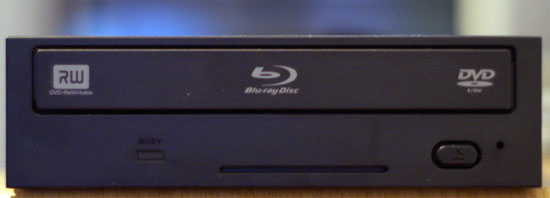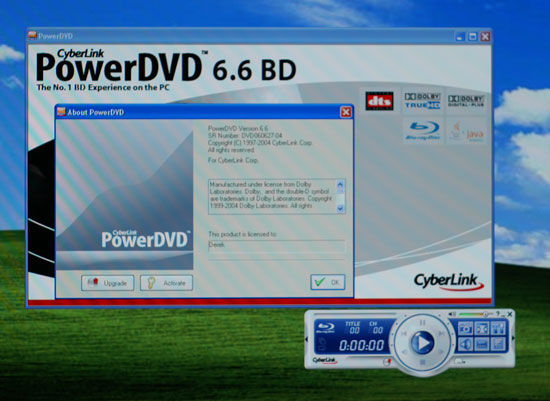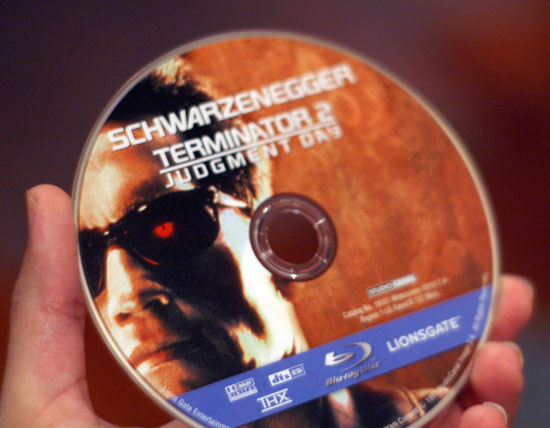NVIDIA and ATI HDCP Compatible Graphics Cards Roundup
by Josh Venning on November 16, 2006 12:00 AM EST- Posted in
- GPUs
Playing a Blu-ray Movie
Before we look at the cards, we want to talk a little bit about our test platform for our HDCP testing in this review. Our Blu-ray drive we have for testing is the Pioneer BDR-101A Bluray player.


Just like watching a regular DVD, in order to watch a Blu-ray movie you'll need a Blu-ray player software. Cyberlink provided us with a version of its Power DVD software that has Blu-ray support (you'll currently need a different version of the player if you have a HD-DVD drive instead). Note that in order to play movies from your Blu-ray or HD-DVD drive over a digital connection, your playback software must have HDCP support or the movie won't play, but most manufacturers should include HDCP compatible software with their Blu-ray or HD-DVD drives.

With the graphics card as the next step in the HDCP chain, not only must the GPU and card be HDCP compatible, but the graphics drivers must have HDCP support as well. Up until very recently, NVIDIA and ATI's public drivers did not include support for HDCP, but this has been added as of their latest Catalyst and ForceWare driver releases.


The last link in the HDCP chain is the display, and an HDCP compatible monitor or TV is required to play our Blu-ray movie. The TV we chose for this is a Westinghouse lvm-42w2, which fully supports HDCP and is a native 1080p display. Of course, you will need a Blu-ray or HD-DVD movie to make use of an HDCP setup to begin with, and the one we have for our testing is the movie "Click" which was one of the first 50GB Blu-ray discs available.

If any one of your hardware or software components within this chain does not support HDCP, then your Blu-ray or HD-DVD movie will not play. Most of the time an error message will pop up and give you an idea of what is wrong; If the graphics card is not HDCP compatible, PowerDVD gave us an error message saying, "fail to enable HDCP. Please switch to analog output (VGA, D-Sub) and try again." If the graphics drivers were incompatible, we got an error message along the lines of "please make sure your graphics drivers support HDCP." These are both fairly straightforward error messages, and for the most part, we were able to tell where the chain was failing whenever we had problems.
If the graphics card itself didn't properly support HDCP the result was a bit more in your face. For instance, we had a X1600 Pro sample with an HDMI port from Sapphire which was listed as being HDCP compatible, but we tried to play our Blu-ray movie we were greeted with a screen full of static.
For the most part, if the card you're using supports HDCP and you've got the right drivers and player, then you're good to go. It's also worth noting that not all outputs on the cards we looked at support HDCP, but where there are limitations we've done our best to point them out in the individual card sections.
Before we look at the cards, we want to talk a little bit about our test platform for our HDCP testing in this review. Our Blu-ray drive we have for testing is the Pioneer BDR-101A Bluray player.


Just like watching a regular DVD, in order to watch a Blu-ray movie you'll need a Blu-ray player software. Cyberlink provided us with a version of its Power DVD software that has Blu-ray support (you'll currently need a different version of the player if you have a HD-DVD drive instead). Note that in order to play movies from your Blu-ray or HD-DVD drive over a digital connection, your playback software must have HDCP support or the movie won't play, but most manufacturers should include HDCP compatible software with their Blu-ray or HD-DVD drives.

With the graphics card as the next step in the HDCP chain, not only must the GPU and card be HDCP compatible, but the graphics drivers must have HDCP support as well. Up until very recently, NVIDIA and ATI's public drivers did not include support for HDCP, but this has been added as of their latest Catalyst and ForceWare driver releases.


The last link in the HDCP chain is the display, and an HDCP compatible monitor or TV is required to play our Blu-ray movie. The TV we chose for this is a Westinghouse lvm-42w2, which fully supports HDCP and is a native 1080p display. Of course, you will need a Blu-ray or HD-DVD movie to make use of an HDCP setup to begin with, and the one we have for our testing is the movie "Click" which was one of the first 50GB Blu-ray discs available.

If any one of your hardware or software components within this chain does not support HDCP, then your Blu-ray or HD-DVD movie will not play. Most of the time an error message will pop up and give you an idea of what is wrong; If the graphics card is not HDCP compatible, PowerDVD gave us an error message saying, "fail to enable HDCP. Please switch to analog output (VGA, D-Sub) and try again." If the graphics drivers were incompatible, we got an error message along the lines of "please make sure your graphics drivers support HDCP." These are both fairly straightforward error messages, and for the most part, we were able to tell where the chain was failing whenever we had problems.
If the graphics card itself didn't properly support HDCP the result was a bit more in your face. For instance, we had a X1600 Pro sample with an HDMI port from Sapphire which was listed as being HDCP compatible, but we tried to play our Blu-ray movie we were greeted with a screen full of static.
For the most part, if the card you're using supports HDCP and you've got the right drivers and player, then you're good to go. It's also worth noting that not all outputs on the cards we looked at support HDCP, but where there are limitations we've done our best to point them out in the individual card sections.










48 Comments
View All Comments
JarredWalton - Thursday, November 16, 2006 - link
Testing was done with an HDTV, because that's almost guaranteed to get HDCP support these days. Some of the newer LCDs have HDCP support (Dell's 2407 and 2007 do I believe), but most do not. That should change, but for now you are less likely to get HDCP with a standard PC display than with an HDTV. So, for HTPCs, you're better off getting just about any LCDTV or plasma in my opinion - watch out for projection HDTVs, as the text for PC use can get pretty garbled. Also beware of plasma burn-in possibilities. My rear-projection HDTV has a bit of burn-in already, and no matter what companies may say, plasma as I understand it is far more prone to such problems. (ESPN HD's logo is burned in on my TV, in case you want to know.)For the cards, features and performance are the two big factors - do you want gaming + HDCP support, just HDCP, or somewhere in between? What about HDMI? If you plan on connecting directly to a TV and using the TV speakers, you'll want HDMI that can include audio (several of the cards reviewed do this). My HDTV for example has an HDMI port, and I can use a DVI-to-HDMI cable to connect to it via just about any modern GPU. The problem is, I can't get audio from the TV without a true HDMI connection.
Finally, OS support is either via Vista, or else you can get an appropriate media player that will handle HDCP content. Testing here was done on XP, so it works already. Will Vista make it better? I personally doubt it, but it won't require extra software apparently (beyond whatever Vista already includes, of course, which is already a lot of "extra").
This article is more intended as an introduction to HDCP cards rather than being the final word. It will become more important over the next year or two, certainly. We'll have discussions on displays and HDCP support in the future.
DerekWilson - Friday, November 17, 2006 - link
Might I also add that 1080p HDTVs seem to make excellent computer monitors. If you want something to do dual duty as a TV and a PC monitor, I can highly recommend a 1080p LCD like the westinghouse we used in this review.If I had the money for either a new monitor or a new TV I'd go with one of these and kill two birds with one stone. And I'd be very very happy about it.
Tujan - Thursday, November 16, 2006 - link
Come on man.Desktop HD "? Smack some of that power onto those 32 to 40 in LCD sets. I know,I know,the angle is just around the corner. The LCD vendors are going have to,sooner,or later realize what their sets mean to the market.The market different from what is being portrayed. And what performance of them mean in it.Has there been any consideration of this.? And in doing so is there any caveats to using the HDTVs when involved with the drivers/hardware..there probably are. Since HDTV sets have somewhat sutured chipsets involved with them.
So in so doing,the idea here for HDCP,being that most of these cards have DVI(HDMI transformer connector)- problems/caveats for proper sound output was not considered. What to look for to consideration of other components,and compatability to HDCP.
Perahps for example I want to look at HD.And HDCP,are we going to limit our computers to a non-player in this area.For example,get on the wire-less keyboard in the living room already.
If I was to realize that electronics stores for example had 'none'of these HDCP enable cards I would be fixing some faces.
But BD,or HD-DVD on the computer screem ?
Come on man. Its chow on those 32",40" LCD HDTV monitors already.
As if Tiawan,Japan,South Korea aren't already in the weeds.I mean helloo.
And AMD-ATI,...-dont be such a lard bottom.!(AMD-ATI).
I mean(Anandtech) easily,get Fries,or Bestbuy to give you the keys to those isles for a night or two.Im sure they'd appreciate your tender convention.
thanks for ability to post here.And good article.
DigitalFreak - Friday, November 17, 2006 - link
Damn dude. I didn't understand a thing you said. Was that Far Eastern Jive or something?Tujan - Friday, November 17, 2006 - link
Here is the test setup page..http://www.anandtech.com/video/showdoc.aspx?i=2874...">http://www.anandtech.com/video/showdoc.aspx?i=2874...
Guess depends on where your standing (and punn ya yes):
-In front of the HDTVs or Video Cards
(retail electronics shop)
- At your work desk putting a computer together (or bench)
- At your desktop reading the Anandtech article....,or In your living room sitting at your couch.
- Maybe looking at your checkbook wondering that you dont 'want to afford a 500$ mistake.
............................
"Far East Jive" ? LOL. Its all Taiwan,Japan,or South Korea making the LCDs. They look really good.
It isn't like you cant see the jungle for the warefare.
________________
Just below here on a forum post the author you'll see that the Display was said to be an HDTV . Though the system stats didn't say "what<- ...uhumn .. Display.
Think that the point of the article was question of fact wether or not the video cards would have performance,and HDCP without sacrificing one or the other.Performance to gaming,and HDCP.
For me as I had first posted would be the testing of these stats/cards to the HDTV LCDs.The author,..again said later within this forum posted that other testing would take place.
Since the caveats against several different HDTV monitors would be exactly different than simply putting together the video card(s).Telling that everything was 'ok'by doing this.With HDTVs you would have to figure compatability via the video cards(to the HDTV) as well as HDTVs (to the video cards.)
This article did not go as far as testing against several HDTVs. With the different video cards(including interaction of software instalation).
The title of my post as 'toes in slippers..hmm". Bears the reasoning that against the backdrop of the 'shelf sets..HD DVD .. Blue-ray..and non-computer .. for the sake of broadcast,and 'media'- the living room LCDTVs are much more than this this.
Its not my business to tell anybody what their business is.Then when electronics vendors are going to ignore the accesories the LCD HDTVs afford to something as 'limited'as broadcast,and media. 'Broadcast,and HD,or Blueray to high definition is 'damn limiting.Thus the 'market'isn't what your being told it is. Just in case you hadn't noticed.
A 500$ mistake makes a difference.The context of that market is all about whats around the corner in so many ways. But where are you standing and whats there to look at ? If that market is ignored in the inventories and on the shelfs...as so on.In that 'limiting'focus.
Now,I've got to figure if my post is 'worth it'. The 32"and 40 LCDTVs are 'worth it. So lets see what they can do. Read some more angles about them before purchasing.
Thanks for reply.
Tarx - Thursday, November 16, 2006 - link
As mentioned above, but worth mentioning again, the X1950Pro is often considered to be the best midrange card currently on the market (relatively fast, not power hungry, fairly low cost, quiet, etc.) - if possible, can this article be amended to include it?DerekWilson - Friday, November 17, 2006 - link
As Josh mentioned above, ATI didn't support playback of HDCP protected content on the X1950 Pro until the release of the 6.11 Catalyst driver which was posted on 11/15/06 (one day before this article was published).We'll absolutely include the X1950 Pro in future articles that cover high definition video playback now that ATI has finally released a public driver for the same.
Spoelie - Thursday, November 16, 2006 - link
article index is broken (fixed)graphic card data is incorrect (x1900xt at 500/600 instead of 625/750? price?)
video table is f*cked up
oblivion settings are not linked (fixed now too)
etc. etc.
still a few cards i would like to see that are still missing, like a x1950pro with 512mb or the x1950xt - and what's the use of testing performance of identical cards, mentioning all hdcp compliant 7950gt and posting performance of one should be sufficient.
Spoelie - Thursday, November 16, 2006 - link
just to be clear, i know what the point is of this article, but since the x1950xt and a comparison between x1950pro 256/512 are both unlikely to get separate articles at this point, using roundups like this would be useful to include them, especially if you're gonna test and post 3d performance in the process :p so that we at least have some point of reference to make buying decisions. maybe something to note for future articles :)Josh Venning - Thursday, November 16, 2006 - link
Thanks for your comment.We did try to test the X1950 Pro for the HDCP review. Unfortunately, there hasn't been a public driver that supports the X1950 Pro since it's launch (that is until Catalyst 6.11 which was posted yesterday). ATI really dropped the ball with X1950 Pro, because the beta drivers they released did not support HDCP either.
We're sorry that we couldn't include this card in the review, but it just wasn't possible to test HDCP with the X1950 Pro until yesterday afternoon.